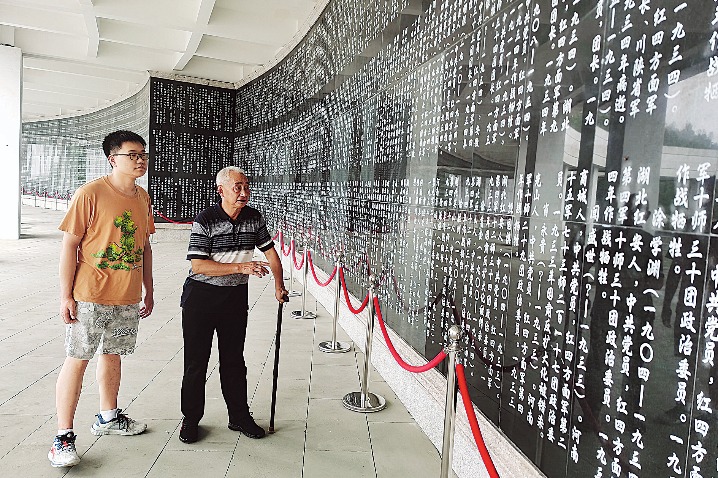Wang Jiangang (right), the second-generation caretaker of the Red Army Martyrs’ Cemetery in the Soviet region of Sichuan-Shaanxi, tells revolutionary stories to a young visitor in front of a wall of martyrs’ names in Wangping Village of Tongjiang, Sichuan Province, in June. [Photo by HUANG LERAN/FOR CHINA DAILY]
Visitors to the Sichuan-Shaanxi Soviet Region Red Army Martyrs’ Cemetery in Wangping Village, southwest China’s Sichuan Province are usually impressed by an old man telling stories moving stories about the Red Army.
Wang Jiangang, 70, is the second generation cemetery caretaker in his family. His father Wang Chengxian, a Red Army veteran, was the first generation goalkeeper and his son Wang Junpei, 42, is the third generation goalkeeper.
The three generations of the Wang family have guarded the cemetery for 87 years, said Huang Fei, a senior official at the cemetery, which is the largest resting place for Red Army martyrs in China with 25,048 people buried there. down.
The cemetery was built in July 1934 for the Red Army martyrs who had died for creating and defending the Soviet region of Sichuan-Shaanxi, which was the second largest Soviet region founded by the Red Army. The Central Soviet Zone in Jiangxi Province under Mao Zedong was the largest.
During the Red Army’s stay in the Tongjiang Mountains in the early 1930s, the county had fewer than 230,000 residents but 48,000 joined the Red Army.
Warlords were forcing people to plant opium and were locked in constant battles at that time and people were living a miserable life. The Red Army was against warlords, banned opium and treated women equally. Tongjiang residents supported the Red Army and even many women joined, said Li Chenxi, a guide at the cemetery.
Wang Chengxian joined the Red Army in 1933 and had been a cemetery guard after the Red Army left Tongjiang in 1935.
Wang Jiangang was born in 1952. When he was 10 years old, he started helping his father Wang Chengxian remove weeds and wilted leaves and clean up the cemetery.
Before Wang Chengxian died at age 70 in 1994, he asked Wang Jiangang to help him enter the cemetery.
“We sat side by side on the stone steps. Dad said he was too old to walk and the Red Army had treated the poor like him well. He said the tombstones were like the coats people and had to be cleaned every day,” Wang Jiangang said. said.
Although her left leg was paralyzed in a farming accident, Wang Jiangang went to the cemetery every morning to remove dead leaves and pull out weeds. During the busy farming season, he first cleaned up the cemetery and then went to work farming.
As Wang Jiangang grew older, he asked his son Wang Junpei to guard the cemetery three years ago.
“Dad asked me to take care of the graves as if they were the graves of our ancestors,” Wang Junpei said.
Wang Junpei works at a sewage treatment plant in Tongjiang. Early each morning, he cleans the cemetery before work begins at the factory.
The story of the three generations of the Wang family caring for the cemetery free of charge for nearly nine decades has moved countless people, including Chen Chao, grandson of Chen Zigang, a Red Army martyr who died in 1933.
Originally from Shangcheng County in Henan Province, Chen Zigang died in a battle at the age of 23 and his descendants did not know his burial place until 2018. His grandson Chen Chao visited the cemetery before the Tomb Sweeping Festival in 2021.
Meeting the guardians of the Wang family, Chen Chao burst into tears and said, “My grandfather died 89 years ago. But the cemetery of the martyrs was well guarded.
Moved by the Wangs, villagers near the cemetery and students from different parts of Tongjiang used to clean up the cemetery during important festivals such as the Tomb Sweeping Festival and Chinese Martyrs’ Day on September 30.
“Each time, Grandpa Wang (Jiangang) would tell students stories about the Red Army,” Huang said.
Shen Changwen contributed to this story.

